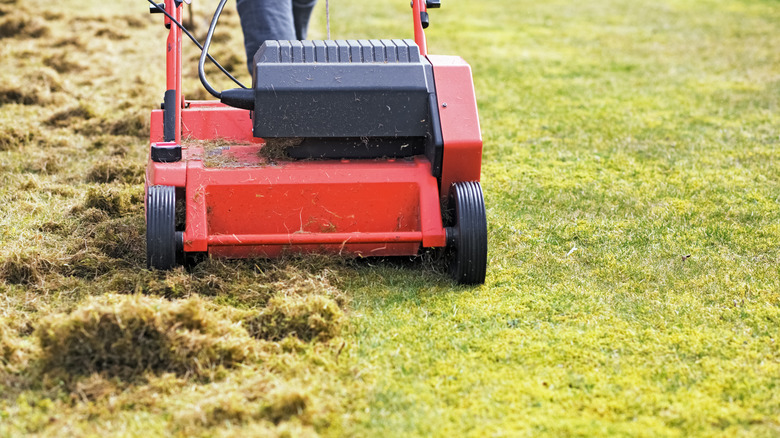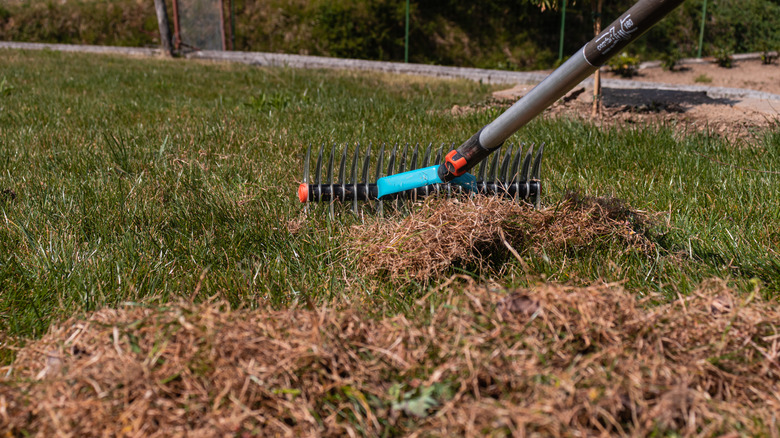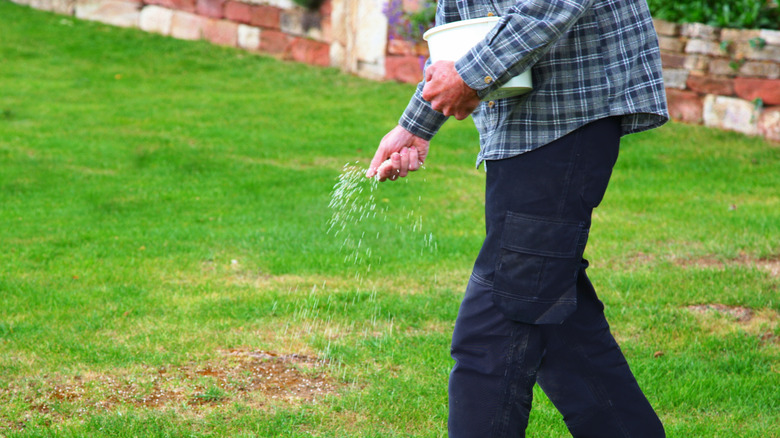How To Know When It's Time To Dethatch Your Lawn
A lush and healthy lawn is the pride of any homeowner, but over time, it can accumulate a layer of dead grass, roots, and debris better known as thatch. To keep your lawn healthy, you'll want to get rid of this stuff, and the best time to do this is during your lawn's active growing season. This is called dethatching, and the season will vary depending on the type of grass. Should you choose not to dethatch your lawn, you're actively asking for turf that will end up less than happy and very sickly. That's because accumulated thatch can prevent proper airflow to the soil and roots, hinder water penetration, and stop up nutrient absorption.
Your lawn mainly absorbs nutrients through its roots, and a thick dead thatch blanket actually acts like a smothering blanket, preventing any aeration of the soil. In addition to the aforementioned, all of that dead, bramble-esque organic matter creates a comfy and cozy little haven for not-so-nice bugs, pests, and fungal and bacterial infections that can seriously put the hurt on your green.
It's a pretty simple process
For a small lawn, you can easily dethatch it by using a lawn mower and a special dethatching rake, which is specifically designed with sharp, closely spaced tines to remove thatch buildup. You can try using a normal rake, but it won't be as effective. Start by mowing your lawn a little shorter than usual, which makes it easier for the dethatching rake to penetrate the thatch. Use your rake to remove the buildup by pulling it through the grass in a backward motion. The rake's tines will stab and lift the dead matter, so you can remove it from the lawn.
Larger lawns are a bit more tedious and time-consuming, so if you're dealing with an ample amount of square footage, it's best to consider renting a vertical mower or a power rake, also known as a dethatching machine. Before you go to town with your dethatching destroyer, follow the same protocol as with a smaller lawn and mow it short. Adjust the dethatching machine to around ¼ to ½ inch above the soil level, and then push it across the lawn. The machine's rotating blades will pull up the thatch and spit it out onto the lawn's surface. Once you've removed the thatch, you can either pick it up by hand or rake it, but you'll want to dispose of it properly by either composting it or putting it in the green waste bin.
Don't overdo it
Dethatching offers significant benefits for your lawn, but it requires careful attention to avoid any potential damage. Timing matters when you're dethatching, and cool-season grasses should be dethatched during their active growth in early spring or early fall. On the other hand, warm-season grasses like should be dethatched in late spring. Over-dethatching should be avoided. It's generally recommended to dethatch once every one to three years, depending on the level of thatch buildup. Additionally, the moisture level of the soil is crucial for successful dethatching, so it's best to go to battle when the soil is slightly moist and not too wet or too dry.
While dethatching can be beneficial in the long run, it's important to prepare for your lawn's recovery after the process. Dethatching can temporarily stress out your lawn, so make sure to water it adequately and consider applying a balanced fertilizer to support it while it's in recovery. As always, if you're unsure about dethatching or have a more expansive property, it's always a good idea to seek out professional help.


